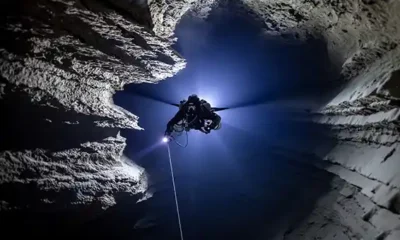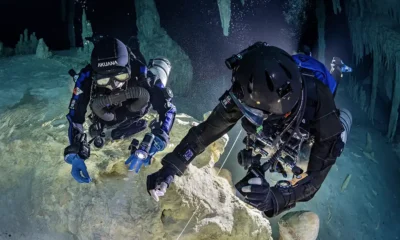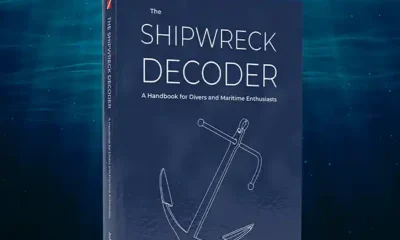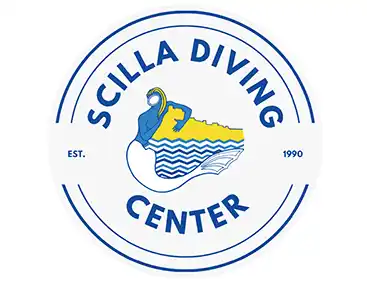News
JJ-CCR Adds a Mouthpiece Retaining Strap
By Ashley Stewart

JJ-CCR recently announced the company will add a device called a “rebreather safety strap” to the closed-circuit rebreather it manufactures, and will provide straps to prior JJ-CCR buyers at no charge, provided they pay the postage.
The device is a version of a mouthpiece retaining strap, sometimes called a gag strap, which is meant to hold a diver’s mouthpiece in place if they lose consciousness.
David Thompson of JJ-CCR told InDEPTH the reason behind the company’s decision to add the straps was a “growing opinion in the diving industry that they are a safety aid,” citing specifically the proceedings of the recent industry workshop Rebreather Forum 4.
Participants of the forum published a consensus statement stating: “The forum recognizes the use of correctly deployed mouthpiece retaining straps as a strategy for avoiding loss of the mouthpiece and minimization of water aspiration in the event of loss of consciousness underwater.” One study of French military divers found mouthpiece retaining straps contributed to a lower fatality rate among those who lost consciousness. Among the 54 loss-of-consciousness events in the study, only 3 fatalities were recorded.
While the study suggests the straps helped avoid fatalities among the divers studied, research around the use of mouthpiece retaining straps is limited, particularly among non-military divers, who are often less physically fit, with less training and a poorer commitment to protocols and equipment maintenance. Importantly, the straps can also complicate safety procedures like bailout.
Jarrod Jablonski of Global Underwater Explorers (GUE) told InDEPTH that he hasn’t seen compelling evidence to suggest mouthpiece retaining straps should be a focus to improve rebreather safety. GUE uses a customized configuration of the JJ for its training and will have to decide how or if to incorporate the straps.
“GUE will comply where required to manage our legal responsibilities, but we do not support mandating the use of such straps through CE or related mechanisms. The evidence for gag straps is exceptionally weak and lacking a vigorous assessment of the problems they might bring,” Jablonski said, adding that there are other more prominent risk factors that should be addressed.
“There are much better ways to improve rebreather safety, and these are well supported by clear and convincing evidence. Insufficient bailout, failure to use checklists, solo diving, novice diver’s using rebreathers, fast-track training programs, and poorly developed diving skills all appear much more prominent risk factors when assessing rebreather fatalities,” Jablonski said. In a pre-RF4 survey, only 73% of attendees indicated they “always” use checklists, 61% of attendees solo dive on their rebreather, and 12% said that they sometimes dive without bailout.

Thompson has yet to respond to a request to address these specific criticisms, but previously said while the evidence supporting the straps is primarily from the military, it’s “none the less good evidence.” The updated JJ-CCR manual also addresses certain potential risks, stating: “If a head strap is used the diver must consider its consequences as it could hinder certain operations while in use i.e. draining water from the mouthpiece assembly and bailout drills, both of which may require the wearer to move the mouthpiece away from the face. As with any change to equipment configuration, relevant drills should be reviewed and practiced before diving with it.”

Diving physiologist Neal Pollock, one of the organizers of RF4, told InDEPTH a lack of research about use of gag straps outside of the military doesn’t necessarily mean they aren’t beneficial to people who dive for sport.
“Gag straps do add complication, and there is little to no direct evidence of the effect of them in the sport diving community,” Pollock said. “The lack of evidence, however, cannot be equated to ‘no benefit;’ since it is a limited use issue. The line has to be walked carefully. A cost-benefit analysis can draw on theoretical risk, anecdotal reports, and experience in other communities.”
DIVE DEEPER
InDEPTH: RTC Launches New Rebreather Safety Initiative
InDEPTH: Can Mouthpiece Retaining Straps Improve Rebreather Diving Safety? By Reilly Fogarty

InDEPTH Managing Editor Ashley Stewart is a Seattle-based journalist and tech diver. Ashley started diving with Global Underwater Explorers and writing for InDEPTH in 2021. She is a GUE Tech 2 and CCR1 diver and on her way to becoming an instructor. In her day job, Ashley is an investigative journalist reporting on technology companies. She can be reached at: ashley@gue.com.




















































